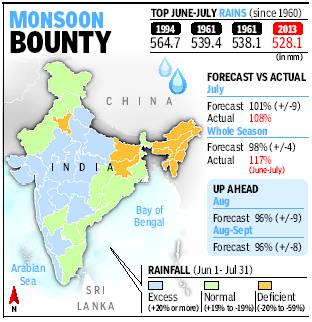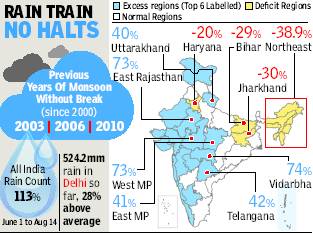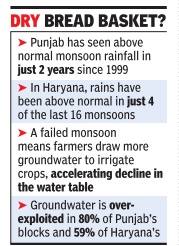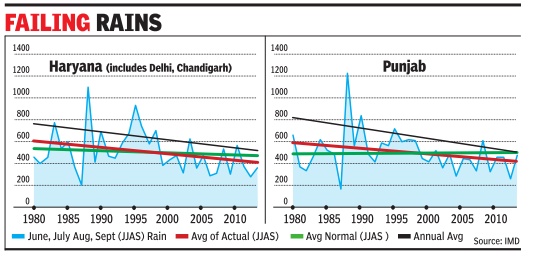Monsoons: India
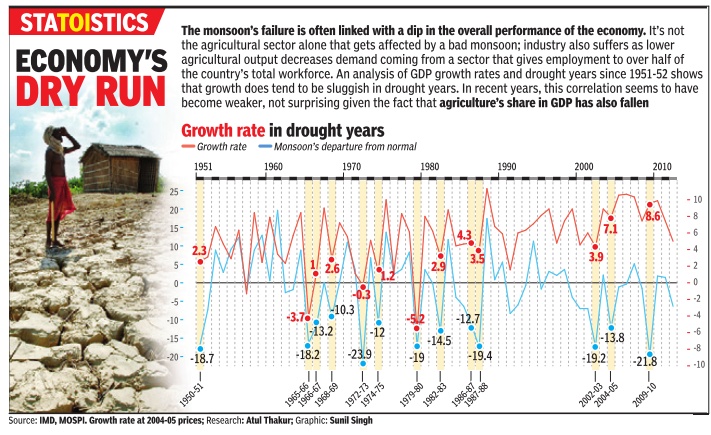
This is a collection of articles archived for the excellence of their content. Readers will be able to edit existing articles and post new articles directly |
Contents |
Monsoons: India
Monsoon going strong, hopes soar
Rains Set To Cross 100% Of Long-Period Average, Record Rice Output Likely
Neha Lalchandani TNN
The Times of India 2013/08/02
A bountiful monsoon normally benefit the kharif crop and augurs good rice production with the area under sowing touching 196 lakh hectares in 2013, a 16 lakh hectare increase over 2012.
Monsoons that crossed the 100% mark
Since 1901, there have been 59 years when the monsoon has crossed 100% of the LPA. Since 2000, there have been only four years when monsoon crossed the 100% mark. These are 2003, 2007, 2010 and 2011. The projection is welcome news for the government as a stuttering monsoon can cast a long shadow on its political fortunes with growth slipping below 5% and high food inflation — prices for consumers rose 11.84% in June — proving a sizeable thorn in the side for UPA-2.
The government hopes the farm sector significantly improves on 2012’s 1.8% growth with R Rangarajan, chairman of the PM’s economic advisory council, saying a normal monsoon could even yield a 3.4% growth.
Monsoons without a break
Non-stop monsoon marches on
Amit Bhattacharya TNN
The Times of India 2013/08/16
One or two periods of a break in monsoon — defined as three straight days of very low rain activity across central India — are common during the rainy season. Since 2000, there have only been three years when there was no monsoon break. And all three years coincided with plentiful rains.
“Two months of monsoon activity without a break is rather rare. It’s an indication of agood monsoon,” said M Rajeevan, senior weather scientist at the earth sciences ministry.
At least four factors have worked in favour of the monsoon in 2013. The first good sign was an absence of El Nino — an anomalous rise in ocean surface temperatures in the east Pacific that is linked to monsoon failure in India.
Currently, weak La Nina conditions exist in the Pacific, which is the opposite of El Nino and is known to help the monsoon here.
“Then, typhoons breaking out over the south Pacific this season have also helped because these have generally moved in a direction that reinforces the Indian monsoon. This is consistent with the weak La Nina conditions,” said Rajeevan.
More importantly, what has helped sustain the rains — and distribute it more or less evenly across the region — has been a series of low pressure formations over the Bay of Bengal that have travelled westwards at regular intervals.
“There have been an unusually high number of low pressure systems, along with cyclonic circulation over land. These have nurtured the monsoon this year, especially in the interior regions of south and central India,” said Pai.
Lastly, Pai said a strong Arabian Sea branch of the monsoon first helped accelerate the rain coverage over the country, and also brought good rains over the west coast.
2015: Monsoons in India
The Times of India, May 30 2015
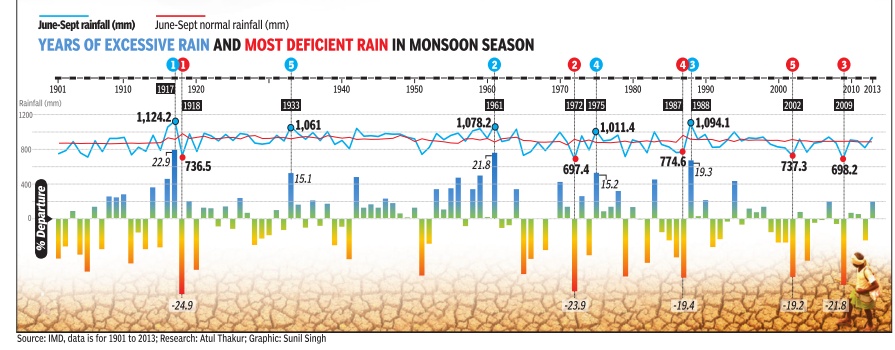

India receives most of the rainfall in four monsoonal months-June, July, August and September. The Met department defines normal monsoon to be 96 to 104% of the long period average, usually the average monsoon over 30 years. If the rainfall deficiency is more than 10%, it would typically be called a drought year. Last year's monsoon was deficient by 12%. This year's monsoon rainfall is predicted to be 93% of the average. If this year's monsoon deficiency crosses 10%, it will be one more year of drought, making it two successive years of drought, an event that has happened only three times in the past 113 years (1904-05, 1965-66 and 1986-87). In 1917, monsoon exceeded normal by the highest percentage (22.9) in 113 years. In 1918, monsoon was deficient by 24.9%, the highest deficiency for this period
2015
The Times of India, Aug 02 2015
Amit Bhattacharya, Vishwa Mohan & Neha Madaan
Dry days: 17% rain deficit in July
After a wet June, when other systems had countered the adverse effects of El Nino, monsoon took a drier turn in July and the month ended with a countrywide rain deficit of 17%. However, kharif sowing remained robust, boost ed by good rain spells in sev eral parts of the country . With the dip in rains monsoon's performance in the first half of the season -June 1 to July 31 -was 5% below the long term average June had a monsoon surplus of 16%.
Heavy rains in Gujarat Rajasthan, West Bengal Jharkhand and parts of cen tral India masked the fact that July this year was the driest since 2002 in terms of average rainfall across the country . The month started on a weak note and rains re mained below par till July 19, except for a brief four day period from the 9th.
But there were several redeeming features. “The rainfall, although weak, has been fairly well distributed across most parts of the country ,“ said D Sivananda Pai, head of India Meteoro logical Department's long range forecasting section.
However, some distress zones of low rainfall have started emerging. Rains were consistently weak through July in south India as well as subdivisions such as Marath wada and Madhya Maharash tra. From July 1 till 29, the southern peninsula recorded the highest rainfall deficien cy in the country , at 46%.
“We had forecast an 8% rainfall deficit for July , but it has turned out to be more. A typical feature this year has been that most rain-causing disturbances have been com ing from the east. Indian Ocean's monsoon circulation has been weak, which means that the monsoon pulses are not progressing from the south, which has caused a significant rainfall deficiency in the southern parts,“ a Met department official said.
However, rains in the north, most parts of central India and many regions of the east were close to normal.This is reflected in the kharif crop sowing figures. The overall sown area has, so far, been far ahead of the corresponding figures last year, which was a bad monsoon year.
The area under kharif as on Friday (July 31) was still less than what was reported at this time in 2013, when rains were plentiful in the monsoon months. As compared to 819.99 lakh hectares as on August 2, 2013, the kharif sown area this year was 764.28 lakh hectares as on July 31.
The monsoon is predicted to be active through the first week of August, raising hopes that the net sown area would grow in the coming days.
Several agencies, howev er, have predicted a relatively dry period in the country after the first week of August when the monsoon could go into a break, increasing the overall rain deficit.
In its monsoon update in June, IMD had forecast a 10% rain deficit in August. The department will issue another update for the second half of the season in a day or two. It had in June predicted a drought year, with overall seasonal rains at 12% below normal. Meanwhile, private forecaster Skymet downgraded its prediction for the season from 102% to 98%, still staying within the normal range.
PM explores ways on sugar exports
M Modi called for renewed P efforts to raise ethanol blending of fuel and exploring all possibilities for sugar exports as he brainstormed with key ministers and officials to resolve the problems faced by the sector.He reviewed the progress with regard to the Rs 6000 crore incentive package approved by the Centre in June and emphasized that the farmers' interest be kept foremost at all times.
Monsoon cycle
The Times of India , Jun 02 2015
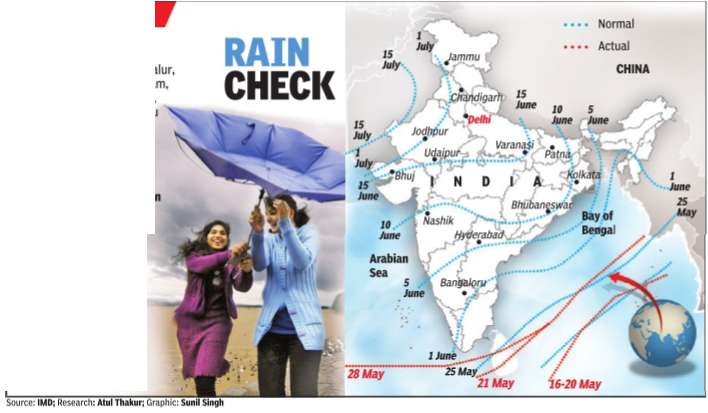
If after May 10, 60% of 14 stations -Minicoy, Amini, Thiruvananthapuram, Punalur, Kollam, Allapuzha, Kottayam, Kochi, Thrissur, Kozhikode, Thalassery, Kannur, Kudulu and Mangalore -report rainfall of 2.5 mm or more for two consecutive days, the onset of the monsoon is declared on the second day. Normally, the monsoon sets in over Kerala around June 1 and then advances northwards. By June 5, it goes past half of Karnataka and Andhra Pradesh and crosses Maharashtra by the 10th.It covers significant portions of Gujarat, Madhya Pradesh and Uttar Pradesh by June 15 and the entire country by June-end.
Monsoon break
A monsoon break — a period when rain activity comes to a stop in most of central India, the region where the monsoon trough is formed — is a common occurrence during the season. “The monsoon has been active without a break since mid-June. This does not happen often and is a reason why the rains were higher than the predicted 101% of LPA for July,” said D Sivananda Pai, IMD’s lead monsoon forecaster. (By Amit Bhattacharya)
Monsoons: date of arrival in various parts of India
See accompanying chart for Delhi
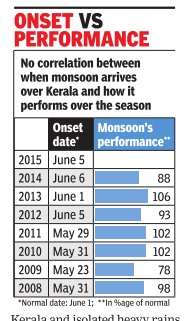
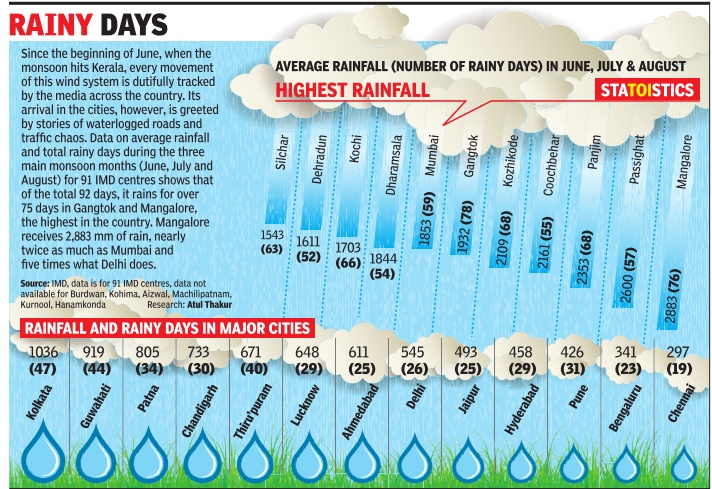
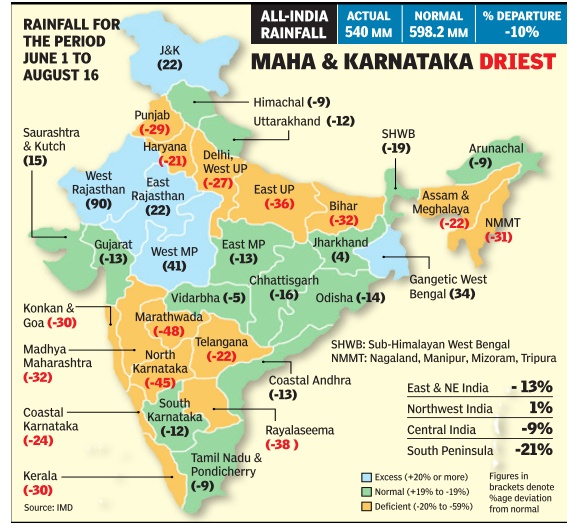
Years in which the monsoon arrived early

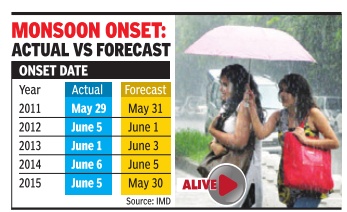
Monsoons in Punjab, Haryana
16-year trend of poor monsoon in Punjab, Haryana
Amit Bhattacharya New Delhi The Times of India Sep 22 2014
India's bread basket states of Punjab and Haryana received just around half the normal rainfall this monsoon season. But more worryingly , this year's rain deficit is not an isolated event. The two key agricultural states have been getting below par rainfall for the past 16 years.
Met department figures reveal Punjab has seen above normal monsoon rainfall in just two years since 1999. The last time that happened was seven monsoons ago, in 2008.The stats are similar for Haryana, where rains have been above normal in just four of the last 16 monsoons.
Experts are divided over why rains have been consistently failing in the region but the trend has dire implications for agriculture, which relies heavily on groundwater. The two states are among the most exploited regions in the world for groundwater.
Deficient rains add another dimension to the crisis.Groundwater mainly de pends on rainfall for recharge. So, less rain means less groundwater availability .A failed monsoon also means farmers draw more ground water to irrigate their crops, particularly paddy , accelerating the fall of the water table.
At TOI's request, Prof Krishna AchutaRao from IIT Delhi's Centre for Atmospheric Sciences plotted the annual and seasonal rainfall in the two states since 1980.The rain stats were obtained from the India Meteorological Department. A linear graph reveals a disturbing trend of decreasing rains in the bread basket of India. It shows average annual rainfall in Punjab falling during this period from just over 800mm in 1980 to less than 600mm in 2014 — a drop of roughly 200mm. Haryana’s annual average shows a similar drop, from around 780mm in 1980 to less than 580mm at present.
For monsoon season rainfall, Punjab has seen a drop of nearly 120mm, from an average of around 600mm in 1980 to roughly 480mm this year.
In Haryana, it’s down from more than 600mm to around 470mm during the same 35year period.
“The long term decrease in rainfall is apparent from the graph,” says AchutaRao, “although the rain statistics for the 1980s show very high variation.” But what’s not so apparent is the cause of the decline.
D Sivananda Pai, head of long range forecasting at IMD Pune, believes the drop is part of natural variability which will get reversed in time.
“Indian monsoon is passing through a low rainfall epoch since the 1990s. The drop in rainfall in this region could be part of that phenom enon,“ says Pai.
The story may not be that straightforward, says AchutaRao, who is coordinating multi-agency research into the Indian monsoon.
2016
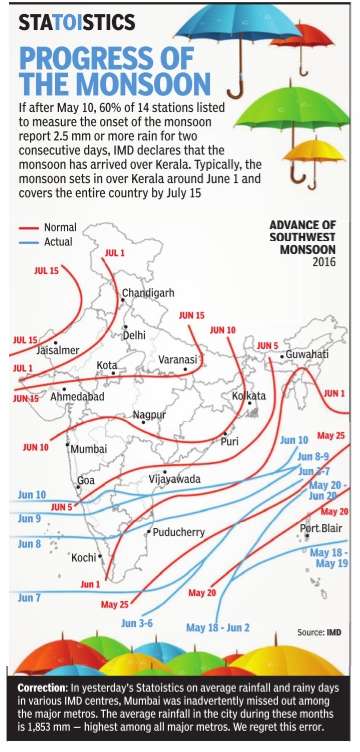
June 2016: 11% Monsoon deficit
The Times of India, July 01, 2016
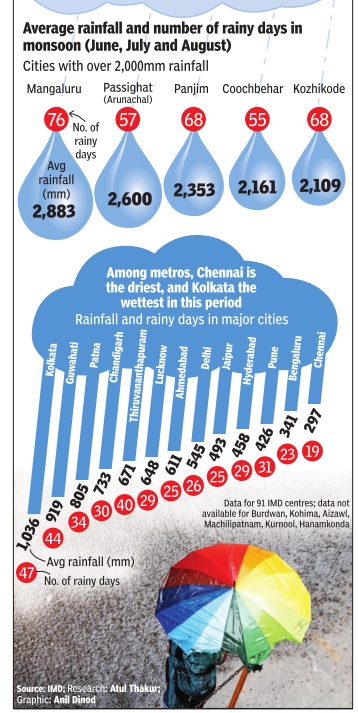
Amit Bhattacharya
11% monsoon deficit in June
Monsoon remained slightly below expectations in the first month of the rainy season as June ended with a countrywide deficit of 11%, mainly on account of a delayed onset. Despite the deficit, however, rains have been in the normal to excess range in around two-thirds of India's 36 meteorological subdivisions. “The deficit in June was mainly due to the eight-day delay in monsoon's onset. It progressed well after that but did not perform as expected in central India.But the shortfall should be made up in July ,“ said D Sivananda Pai, lead monsoon forecaster at the India Meteorological Department.
The Met department expects rains to pick up in July , the most crucial month of the season for kharif sowing.Monsoon's performance in July is also important for water recharge as it accounts for almost a third of the total seasonal rainfall. By contrast, June normally gets only around 18% of the total monsoon rains.
“The monsoon hit the country only on June 8. So, we have got just about three weeks of monsoon rains so far. By that measure, an 11% shortfall is well within range,“ said B P Yadav, director, IMD. Among the meteorological regions of the country , south India received the best rain bounty , with 22% excess rains in June.Although the monsoon is yet to arrive in many parts of northwest India, the region had just a2.4% rain shortfall because of fairly good pre-monsoon showers in states such as Punjab.
The highest shortfall was in east and northeast India, where June ended with a 27.3% deficit. The performance wasn't totally unexpected because the region is predicted to receive less rains this year.
The region where monsoon has been more or less disappointing is central India, which had an 18.2% deficit in June. Except for Konkan and Goa, Marathwada and west Madhya Pradesh, rainfall has been less than average in all subdivisions of the region.
While Odisha and east MP are expected to get rains in the next days, other subdivisions in the region where the deficit is high -Gujarat and Madhya Maharashtra -may have to wait a few more days for good rainfall, Met officials said.These areas too would get good monsoon showers in July , they added. “In the next few days, monsoon activity is likely to be concentrated in northwest India and adjoining parts of central India. We expect monsoon to hit Delhi, Haryana, Punjab and more parts of UP and Rajasthan in the next two-three days,“ said Yadav.
Deficit hampers kharif sowing
The Times of India, Jul 02 2016
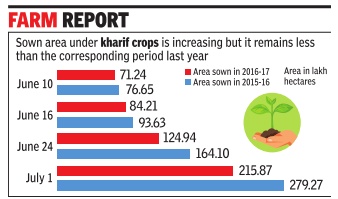
Vishwa Mohan
Deficit rainfall hampers kharif sowing in June 2016 Deficit monsoon rains in June has affected the overall kharif sowing operation in the month, keeping the sown area low as compared to the corresponding period last year but the area under paddy has shown improvement for the first time this season as compared to 2015-16. Kharif sown area data, released by the agriculture ministry on Friday , put the total area at 215.87 lakh hectare as on July 1 as compared to 279.27 lakh hectare at this time last year. However, the paddy recorded marginal increase by covering 47.77 lakh hectare so far this year as compared to 47.62 lakh hectare in 2015-16.
Sowing operations, which remained sluggish during the first three weeks after the onset of monsoon, picked up pace in the past one week due to good rains in south India -covering over 90 lakh hectare under various crops in the past seven days.
“Though the area under kharif crops, including pulses, oilseeds and cotton, is still less than the area during the corresponding period last year due to 11% of deficit rainfall in June, the sowing operation will further pick up in July and hopefully cross the last year's sown area by the end of this month“, said an official.
Areas under pulses and oilseeds will, however, continue to be a major concern.Sown area under oilseeds stands at merely 28.71 lakh hectare as on Friday as compared to 54.24 lakh hectare at this time last year. Similarly, cotton too recorded poor sowing as its sown area stands at 30.59 lakh hectare as compared to 60.16 lakh hectare in the 2015-16.
The availability of water in the country's 91 major reservoirs has marginally increased from 23.20 billion cubic meter (BCM) on June 23 to 23.94 BCM as on June 30 despite constant withdrawal of water from them.
According to the Central Water Commission, Rajasthan, Tripura and Andhra Pradesh have better storage in 2016 than the corresponding period in 2015.
